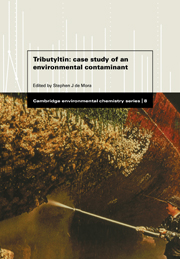Book contents
- Frontmatter
- Contents
- Contributors
- Preface
- 1 The tributyltin debate: ocean transportation versus seafood harvesting
- 2 Industrial manufacture and applications of tributyltin compounds
- 3 The analysis of butylated tin compounds in the environment and in biological materials
- 4 The occurrence, fate and toxicity of tributyltin and its degradation products in fresh water environments
- 5 The distribution and fate of tributyltin in the marine environment
- 6 Biological effects of tributyltin on marine organisms
- 7 TBT-induced imposex in neogastropod snails: masculinization to mass extinction
- 8 Environmental law and tributyltin in the environment
- 9 The efficacy of legislation in controlling tributyltin in the marine environment
- Index
8 - Environmental law and tributyltin in the environment
Published online by Cambridge University Press: 04 August 2010
- Frontmatter
- Contents
- Contributors
- Preface
- 1 The tributyltin debate: ocean transportation versus seafood harvesting
- 2 Industrial manufacture and applications of tributyltin compounds
- 3 The analysis of butylated tin compounds in the environment and in biological materials
- 4 The occurrence, fate and toxicity of tributyltin and its degradation products in fresh water environments
- 5 The distribution and fate of tributyltin in the marine environment
- 6 Biological effects of tributyltin on marine organisms
- 7 TBT-induced imposex in neogastropod snails: masculinization to mass extinction
- 8 Environmental law and tributyltin in the environment
- 9 The efficacy of legislation in controlling tributyltin in the marine environment
- Index
Summary
Introduction
The pesticide tributyltin (TBT) is part of a family of organotin compounds, the biocidal properties of which were first recognised in the early 1950s. TBT is extremely harmful to marine organisms. This character has been exploited with TBT used as the active ingredient in many formulations of marine antifouling paints. These paints are applied to boat hulls and other submerged structures, such as wharves, buoys, and fishpens to prevent fouling, that is, the attachment and growth of marine organisms such as barnacles, mussels, and algae. These fouling organisms contribute to corrosion and to the floating weight of vessels. They also produce turbulent flow and increase drag across the hulls of ships, thus decreasing speed and increasing fuel consumption. The antifouling paints work in the following way. Once the biocide is released from the paint film, a thin envelope of highly concentrated TBT is formed around the vessel hull. The larvae of fouling or nuisance organisms are killed or repelled when they encounter this layer, thus protecting the vessel.
Because of their extreme toxicity, and their longer useful lifespan – seven years as compared to the two years of copper alternatives – TBT compounds are the most effective antifouling agents so far devised. Their application can save vessel operators hundreds of millions of dollars annually in fuel and maintenance costs. For example, the Environmental Protection Agency (EPA) of the United States has found that the United States Navy, by using TBT copolymer antifoulants, could save an estimated US$130 million a year over the standard copper formula.
- Type
- Chapter
- Information
- TributyltinCase Study of an Environmental Contaminant, pp. 237 - 263Publisher: Cambridge University PressPrint publication year: 1996
- 23
- Cited by



